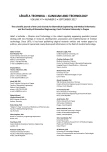DESIGN OF AN EXPERIMENTAL LASER SPECKLE CONTRAST IMAGING SYSTEM AND IMAGE
Laser speckle contrast imaging (LSCI) is a noninvasive method, which uses scattered light to estimate the flow of a fluid containing scatterers. Thus, it can be especially used to estimate blood flow. Laser light is randomly scattered on the tissue and this refracted light interfere with reflected light, giving birth to laser speckle noise. As the light scatters on moving red blood cells, the speckle pattern is blurred due to the exposition time. This blurring is a function of velocity which can be estimated from the degree of blur, termed as speckle contrast. Therefore, blood cells act like contrast agent, outlining blood vessels. The simple setup, unnecessary contrast agent and unharming nature are making LSCI a popular tool for studying blood flow dynamics and vascular structure. This paper presents a new, simple experimental setup and image processing methods to treat laser speckle images aiming to estimate relative blood flow and vascular structure.
Keywords:
LSCI, laser speckle contrast imaging, blood flow, speckle noise
Autoři:
Branislav Hesko; Vratislav Harabiš; Radim Kolář
Působiště autorů:
Department of Biomedical Engineering, BUT, Brno, Czech Republic
Vyšlo v časopise:
Lékař a technika - Clinician and Technology No. 3, 2017, 47, 101-107
Kategorie:
Původní práce
Souhrn
Laser speckle contrast imaging (LSCI) is a noninvasive method, which uses scattered light to estimate the flow of a fluid containing scatterers. Thus, it can be especially used to estimate blood flow. Laser light is randomly scattered on the tissue and this refracted light interfere with reflected light, giving birth to laser speckle noise. As the light scatters on moving red blood cells, the speckle pattern is blurred due to the exposition time. This blurring is a function of velocity which can be estimated from the degree of blur, termed as speckle contrast. Therefore, blood cells act like contrast agent, outlining blood vessels. The simple setup, unnecessary contrast agent and unharming nature are making LSCI a popular tool for studying blood flow dynamics and vascular structure. This paper presents a new, simple experimental setup and image processing methods to treat laser speckle images aiming to estimate relative blood flow and vascular structure.
Keywords:
LSCI, laser speckle contrast imaging, blood flow, speckle noise
Zdroje
[1] Madsen, S.: Optical Methods and Instrumentation in Brain Imaging and Therapy: 3 (Bioanalysis). Springer, 2012, 280 p, ISBN: 978-1-4614-4978-2.
[2] Fercher, A. F. and Briers, J. D.: Flow visualization by means of single-exposure speckle photography. Optics Communications 37(5), 1981, p. 326–330.
[3] Briers, D., Duncan, D. D. et al.: Laser speckle contrast imaging: theoretical and practical limitations. Journal of Biomedical Optics 18(6), june 2013, 10 p.
[4] Millet, C. et al.: Comparison between laser speckle contrast imaging and laser doppler imaging to assess skin blood flow in humans. Microvascular Research 82/2, 2011, p. 147–151.
[5] Roustit, M. et al.: Excelent reproducibility of laser speckle contrast imaging to assess skin microvascular reactivity. Mikrovascular Research 80(3), 2010, p. 505–511.
[6] Kirkpatrick, S.J et al.: Detrimental effects of speckle-pixel size matching in laser speckle contrast imaging. Optics letters, 33(24):2886, dec. 2008.
[7] Dunn, A. K.: Speckle contrast imaging of cerebral blood flow. Annals of Biomedical Engineering 40(2), p. 367–377, nov. 2011.
[8] Cheng, H., Yan, Y. and Duong, T. Q.: Temporal statistical analysis of laser speckle images and its application to retinal blood-flow imaging. Optics Express 16(14), 2008.
[9] Boas, D.A and Dunn, A.K. Laser speckle contrast imaging in biomedical optics, Journal of Biomedical Optics, 2010.
[10] Cheng, H and Duong, T. Q.: Simplified laser-speckle-imaging analysis method and its application to retinal blood flow imaging. Optics Letters 32(15), 2007.
[11] Richards, L. M. et al.: Low-cost laser speckle contrast imaging of blood flow using a webcam. Biomedical Optics Express 4(10), 2013, p. 2269–2283.
[12] Yuan, S., Devor, A., Boas, A. and Dunn, A. K.: Determination of optimal exposure time for imaging blood flow changes with laser speckle contrast imaging. Applied Optics, 44(10), 2005, p. 18–23.
[13] Mahé, G. et al.: Air movements interfere with laser speckle contrast imaging recordings. Laser in medical science, 27(5), 2012, p. 1073–1076.
Štítky
BiomedicínaČlánok vyšiel v časopise
Lékař a technika

2017 Číslo 3
Najčítanejšie v tomto čísle
- DEVELOPMENT OF NEW TECHNIQUE FOR ACCURATE WEAR ANALYSIS OF EXPLANTED TOTAL HIP REPLACEMENTS
- RELIABILITY AND SOURCE OF ERRORS IN END-TIDAL GAS CONCENTRATION EVALUATION ALGORITHMS DURING AVALANCHE SNOW AND REBREATHING EXPERIMENTS
- DESIGN OF AN EXPERIMENTAL LASER SPECKLE CONTRAST IMAGING SYSTEM AND IMAGE
- DETERMINATION OF THE GEOMETRICAL AND VISCOELASTIC PROPERTIES OF SCAFFOLDS MADE BY ADdITIVE MANUFACTURING USING BIOPLOTTER
